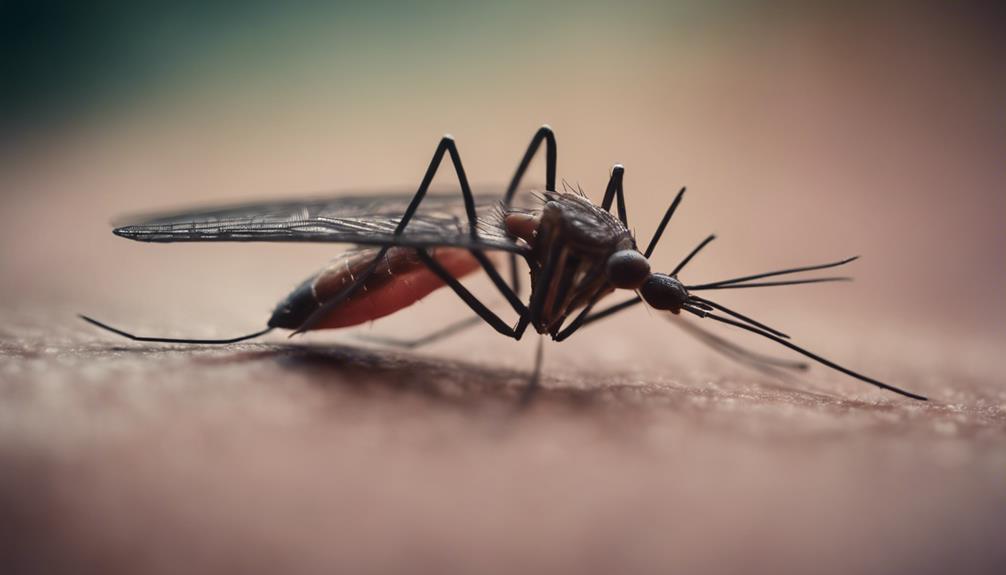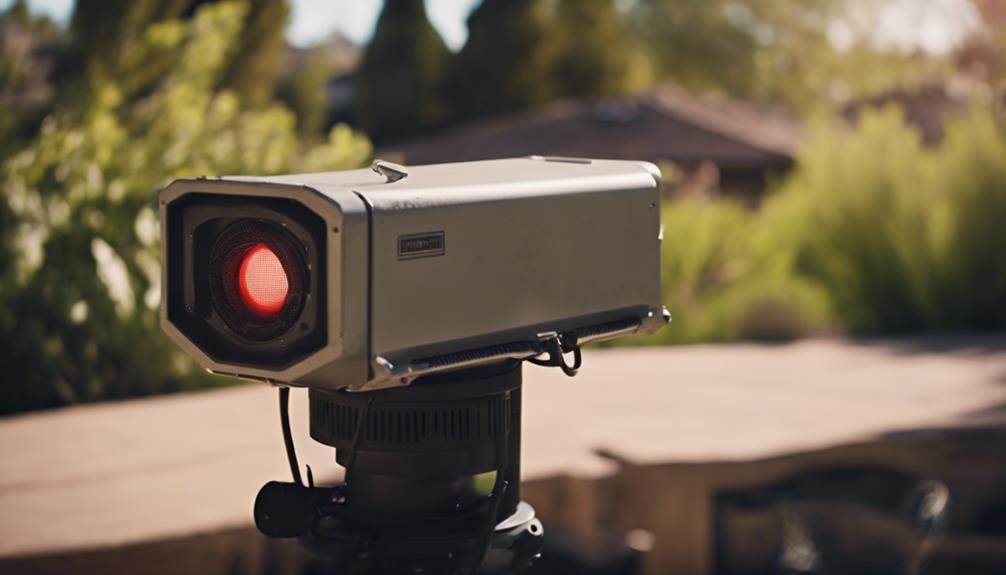To identify different mosquito species in St. St. George, examine physical features. Aedes mosquitoes display black and white patterns. Culex mosquitoes possess black bodies with white bands. Anopheles mosquitoes are dark brown with distinct patterns. Understand their behaviors – flight patterns and feeding habits are essential. Investigate breeding habitats like stagnant water in ponds and birdbaths. Look for larvae or pupae in standing water. More details on species, diseases they carry, and control methods are vital for accurate identification and management.
Key Takeaways
- Look for black and white patterns on bodies and legs for Aedes mosquitoes.
- Identify Culex mosquitoes by their black bodies with white bands on proboscis and tarsal joints.
- Anopheles mosquitoes have dark brown to black coloration with specific body patterns.
- Observe flight patterns, feeding habits, and breeding preferences to distinguish mosquito species.
- Check stagnant water sources like ponds and birdbaths for mosquito larvae to identify breeding sites.
Physical Characteristics of Mosquito Species
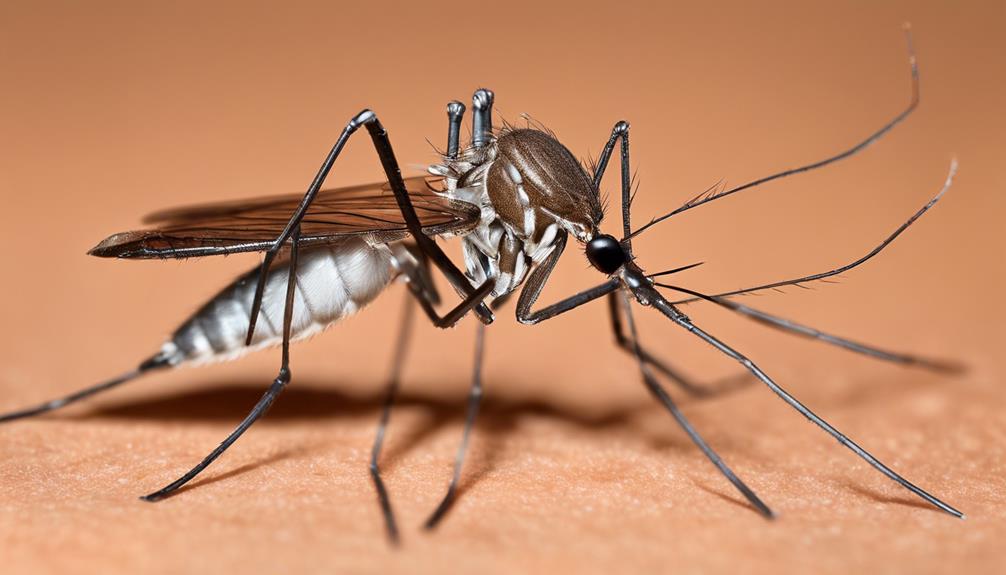
When identifying different mosquito species in St. George, it’s essential to closely examine their physical characteristics, which can vary greatly in size, color, and distinctive markings.
Females of various mosquito species exhibit unique features that aid in their recognition. For instance, Aedes mosquitoes, notorious for transmitting diseases like Zika and dengue fever, display striking black and white patterns on their bodies and legs.
In contrast, Culex mosquitoes, responsible for diseases such as encephalitis, can be identified by their black bodies adorned with white bands on their proboscis and tarsal joints.
Anopheles mosquitoes, carriers of malaria, exhibit a dark brown to black coloration with specific patterns on various body segments. Understanding these physical attributes is paramount for accurate identification, especially since female mosquitoes are the ones transmitting diseases and laying eggs.
Behavioral Traits for Mosquito Identification
When identifying different mosquito species in St. St. George, pay close attention to their flight patterns, feeding habits, and breeding preferences. Understanding these behavioral traits is essential in accurately distinguishing between Anopheles, Aedes, and Culex mosquitoes.
Observing how they interact with their environment can provide valuable insights for effective mosquito identification strategies.
Flight Patterns
To identify different mosquito species in St. George based on their flight patterns, it is important to observe the timing of their activity, as various species exhibit distinct diurnal or nocturnal behaviors. By understanding when mosquitoes are most active, you can gain valuable insights into the species present. Below is a table outlining the flight patterns of common mosquito species in St. George:
| Species | Flight Patterns | Feeding Behavior |
|---|---|---|
| Aedes mosquitoes | Daytime | Diurnal feeders |
| Anopheles mosquitoes | Nighttime | Nocturnal feeders |
| Culex mosquitoes | Nighttime | Nocturnal feeders |
| Psorophora mosquitoes | Daytime | Diurnal feeders |
| Coquillettidia mosquitoes | Nighttime | Nocturnal feeders |
Feeding Habits
By analyzing the feeding habits of mosquitoes in St. George, researchers can effectively distinguish between various species based on their dietary preferences and behaviors. Mosquito species in St. George exhibit diverse feeding habits, with some preferring blood meals from mammals, birds, and amphibians.
Importantly, species like Aedes mosquitoes display a preference for human blood meals during the day, which is vital for disease control efforts. Understanding these feeding behaviors is essential for identifying potential disease vectors and implementing targeted control measures.
Additionally, while mosquitoes primarily feed on blood for reproduction, they also feed on nectar and plant juices, contributing to pollination and ecosystem balance. By studying the intricate feeding habits of different mosquito species, experts can develop precise strategies for effective mosquito control and disease prevention in St. George.
Breeding Preferences
Analyzing the breeding preferences of different mosquito species reveals distinctive behavioral traits important for their identification and targeted control measures.
The Asian Tiger Mosquito, also known as Aedes albopictus, prefers laying eggs near water sources like flower pots, tires, or bird baths.
Anopheles mosquitoes, carriers of malaria, opt for clean, clear water bodies such as ponds, lakes, or marshes for breeding.
In contrast, Culex mosquitoes, which spread diseases like encephalitis, thrive in polluted water sources like sewage drains or ditches.
Recognizing these breeding preferences is essential for effective mosquito population control strategies tailored to specific species. By understanding where each species lays its eggs, targeted interventions can be implemented to mitigate their proliferation and reduce the risk of disease transmission.
Identifying Mosquito Breeding Habitats
Inspect potential breeding sites for mosquitoes in St. George, focusing on stagnant water sources like ponds, birdbaths, clogged gutters, and discarded tires.
Look for mosquito larvae or pupae wriggling in standing water, indicating active breeding habitats.
Regularly check areas with dense vegetation, as they may harbor mosquitoes seeking shelter and breeding grounds.
Water Sources for Breeding
To effectively identify potential breeding habitats for mosquitoes in St. St. George, it’s crucial to recognize that stagnant water sources like ponds, birdbaths, rain barrels, and clogged gutters are common breeding grounds.
- Ponds: Mosquitoes breed in still water found in ponds.
- Birdbaths: Standing water in birdbaths provides a suitable environment for mosquito breeding.
- Rain Barrels: Stagnant water collected in rain barrels serves as a breeding site for mosquitoes.
- Clogged Gutters: Water accumulation in clogged gutters can become a breeding ground for mosquitoes.
Inspecting and eliminating these water sources can greatly reduce mosquito breeding habitats, helping to control mosquito populations around your living spaces. Regular maintenance to prevent standing water accumulation is crucial in combating potential mosquito breeding sites in St. George.
Common Breeding Habitats
With a keen eye for potential breeding grounds, one must meticulously survey various stagnant water sources to identify common habitats for mosquito reproduction. Mosquitoes are notorious for breeding in standing water, making it essential to eliminate these breeding grounds to control their population effectively. Common breeding habitats include ponds, marshes, ditches, birdbaths, tires, buckets, flower pots, clogged gutters, and even discarded items like bottle caps and cans that collect rainwater. These areas provide the perfect environment for mosquito larvae to thrive, with organic debris and algae serving as vital nutrients. By identifying and removing these stagnant water sources, you can significantly decrease the mosquito population in St. George.
| Common Breeding Habitats | Description |
|---|---|
| Ponds | Natural stagnant water bodies where mosquitoes lay eggs. |
| Tires | Artificial containers that collect water, providing a breeding ground. |
| Clogged Gutters | Accumulation of debris and water, ideal for mosquito reproduction. |
Recognizing Common Mosquito Species in St. George
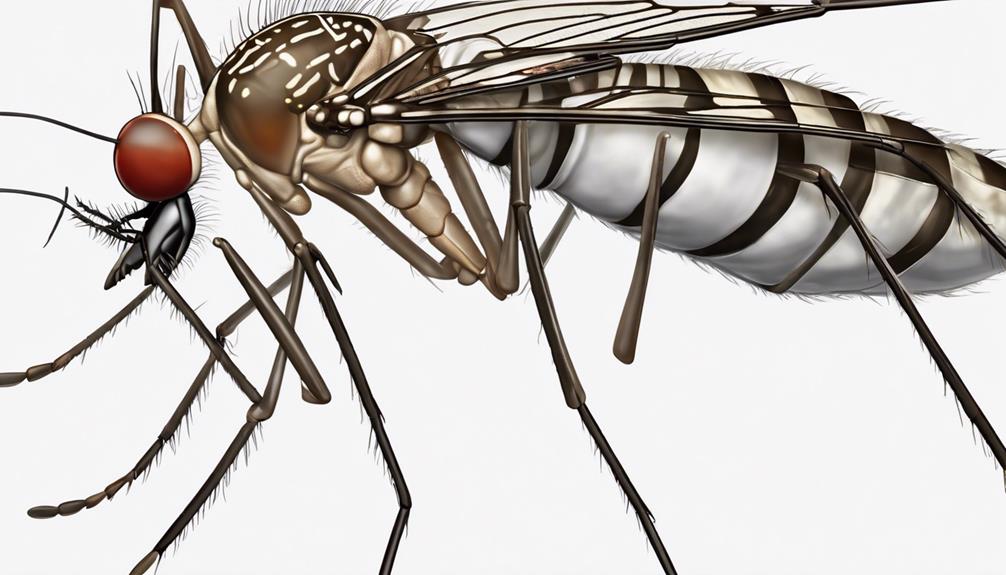
When observing mosquitoes in St. George, it’s important to recognize the distinct characteristics of the common species present, such as Anopheles, Aedes, and Culex.
- Anopheles: These mosquitoes are notorious for transmitting malaria. They’ve dark brown to black bodies with clear body sections, making them distinguishable from other species.
- Aedes: Known for spreading diseases like Zika and dengue fever, Aedes mosquitoes have striking black and white markings on their bodies and legs, standing out in appearance.
- Culex: Responsible for transmitting encephalitis, Culex mosquitoes can be identified by their black bodies with white bands on their proboscis and tarsal joints, aiding in differentiation from other species.
- Understanding the Differences: Being able to differentiate these mosquito species by their unique features is essential for residents in St. George. This knowledge not only helps in identification but also aids in implementing targeted control measures for effective mosquito management.
Mosquito Species With Disease Transmission Risk
How do the different mosquito species found in St. George contribute to disease transmission risks?
Anopheles mosquitoes in St. George are the primary vectors for malaria transmission, posing a significant health threat in the area.
Culex mosquitoes, also prevalent in St. George, can transmit encephalitis, emphasizing the critical need for robust mosquito control measures.
Additionally, Aedes mosquitoes found in St. George play a pivotal role in transmitting diseases such as Zika virus and dengue fever, impacting public health in the region.
The presence of these disease-carrying mosquito species underscores the urgency for effective surveillance and control strategies.
To mitigate disease transmission risks, understanding the distinct characteristics and behaviors of each mosquito species is essential.
Implementing Targeted Mosquito Control Measures
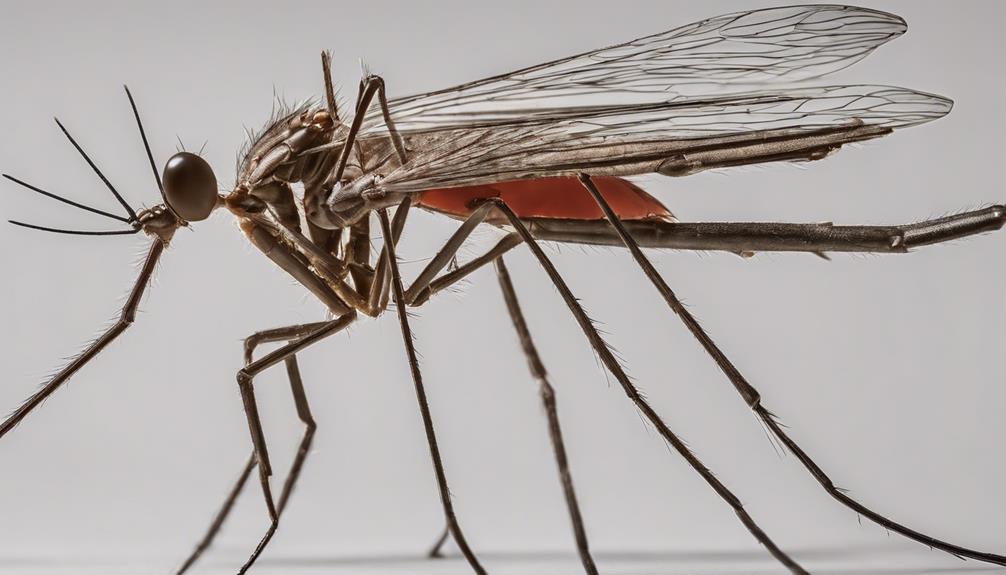
To effectively combat mosquito populations in St. St. George, targeted control measures must be meticulously implemented. By following specific strategies tailored to different stages of the mosquito life cycle and utilizing various tools, you can effectively reduce mosquito populations in your area.
- Larvicides: Use products like Bacillus thuringiensis israelensis (BTI) in water sources where mosquito larvae thrive, targeting them without harming other organisms.
- Adulticides: Employ adult-targeting chemicals like pyrethroids and organophosphates in areas with high adult mosquito activity to control populations effectively.
- Traps: Utilize gravid traps and ovitraps to monitor and reduce Aedes albopictus populations, aiding in the targeted control of these mosquitoes.
- Integrated Mosquito Control: Collaborate with local authorities and communities to implement holistic strategies that combine various control methods for sustainable results in St. George.
Preventing Mosquito-Borne Diseases in St. George
Prevent mosquito-borne diseases in St. George by implementing all-encompassing strategies that focus on eliminating breeding grounds and promoting personal protective measures. St. George residents play a vital role in reducing the risk of mosquito-borne illnesses by actively participating in prevention efforts.
To safeguard against mosquito bites, individuals should use insect repellent containing DEET and wear appropriate clothing such as long sleeves and pants, especially during peak mosquito activity times. Additionally, eliminating standing water sources around homes and communities is paramount as these serve as breeding grounds for mosquitoes.
Mosquito control activities in St. George may involve larvicide treatments in stagnant water bodies and adulticide fogging in high-risk areas to curb mosquito populations. Educational campaigns are essential to raise awareness among residents about the significance of mosquito control and personal protection measures.
Health authorities in St. George conduct surveillance for mosquito-borne diseases to implement targeted control measures based on monitoring data, ensuring the well-being of the community.
Frequently Asked Questions
How Do I Identify Different Types of Mosquitoes?
Wondering how to identify different types of mosquitoes? Look for distinctive features like white bands on the body and legs for Aedes, dark brown coloring for Anopheles, and black appearance with white bands for Culex.
What Types of Mosquitoes Are in Utah?
In Utah, you’ll find Anopheles, Aedes, and Culex mosquitoes. Anopheles spread malaria, Aedes carry Zika, yellow fever, and dengue, while Culex transmit encephalitis and West Nile virus. Recognizing these species is essential for effective mosquito prevention and control in St. George.
Are There Mosquitoes in St George Utah?
Yes, there are mosquitoes in St. George, Utah. The mosquito population increases during warmer months due to breeding. Prevent mosquito bites by using repellent. Control measures focus on reducing breeding sites. Stay vigilant to protect yourself.

